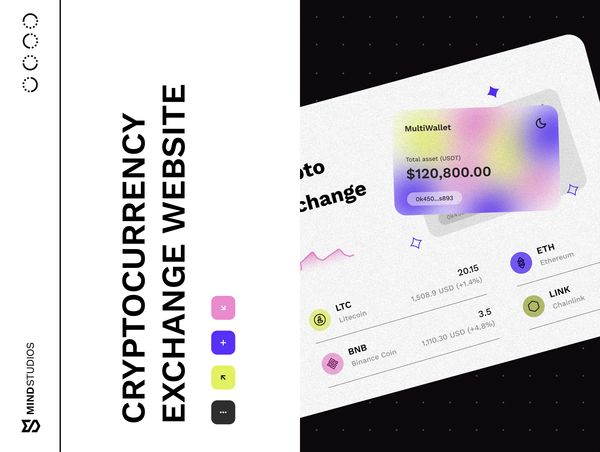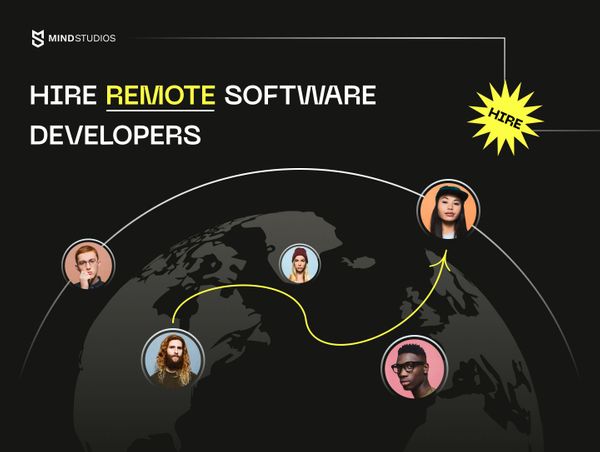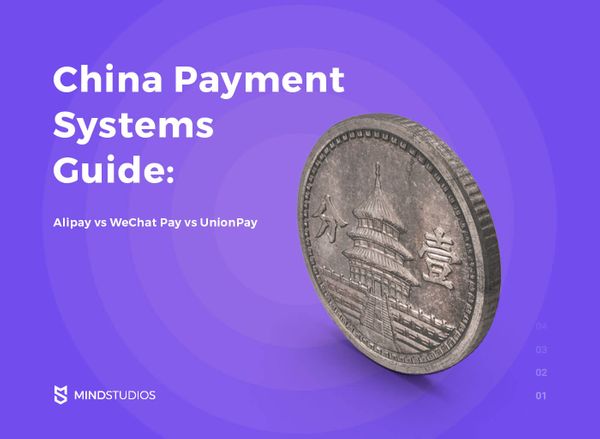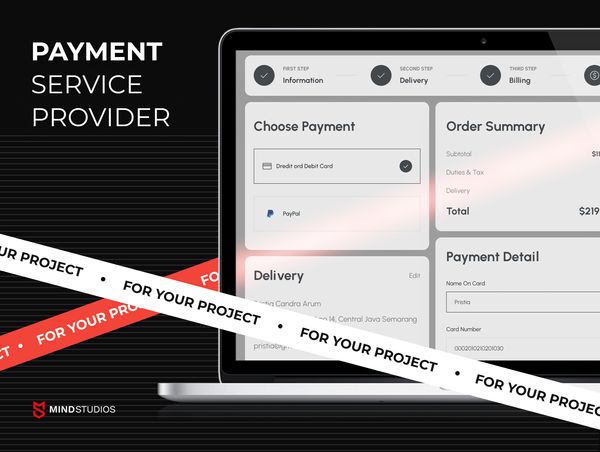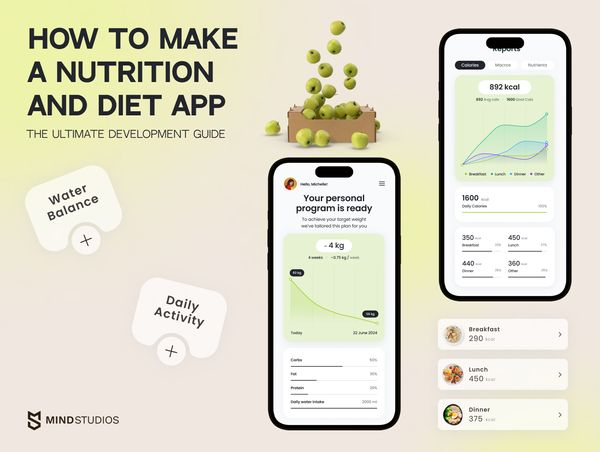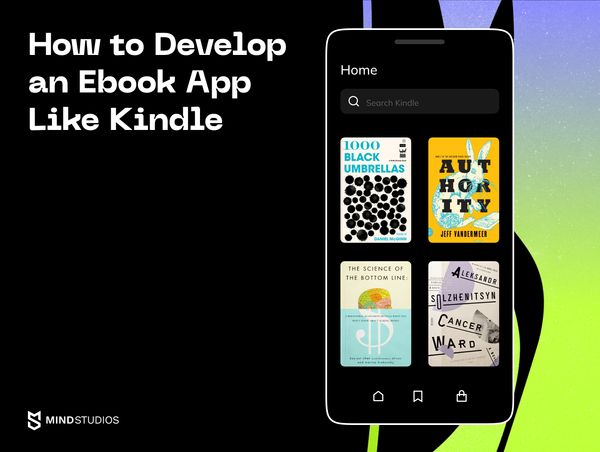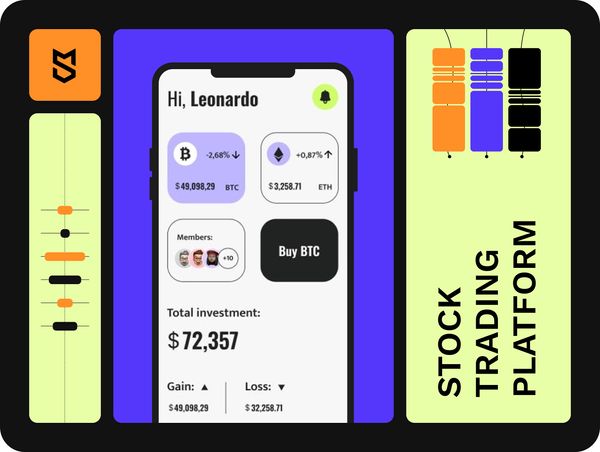
In recent years, the market has seen an increase in stock trading apps. You’ve probably heard of E-Trade and perhaps the Robinhood app. In parallel with stocks, the demand for cryptocurrency trading is steadily increasing.
But you no doubt knew all that since you’re already planning to make a custom trading platform. So without further ado, let’s talk about how to build a trading platform that will take your business to the next level.
Choose the right trading platform type
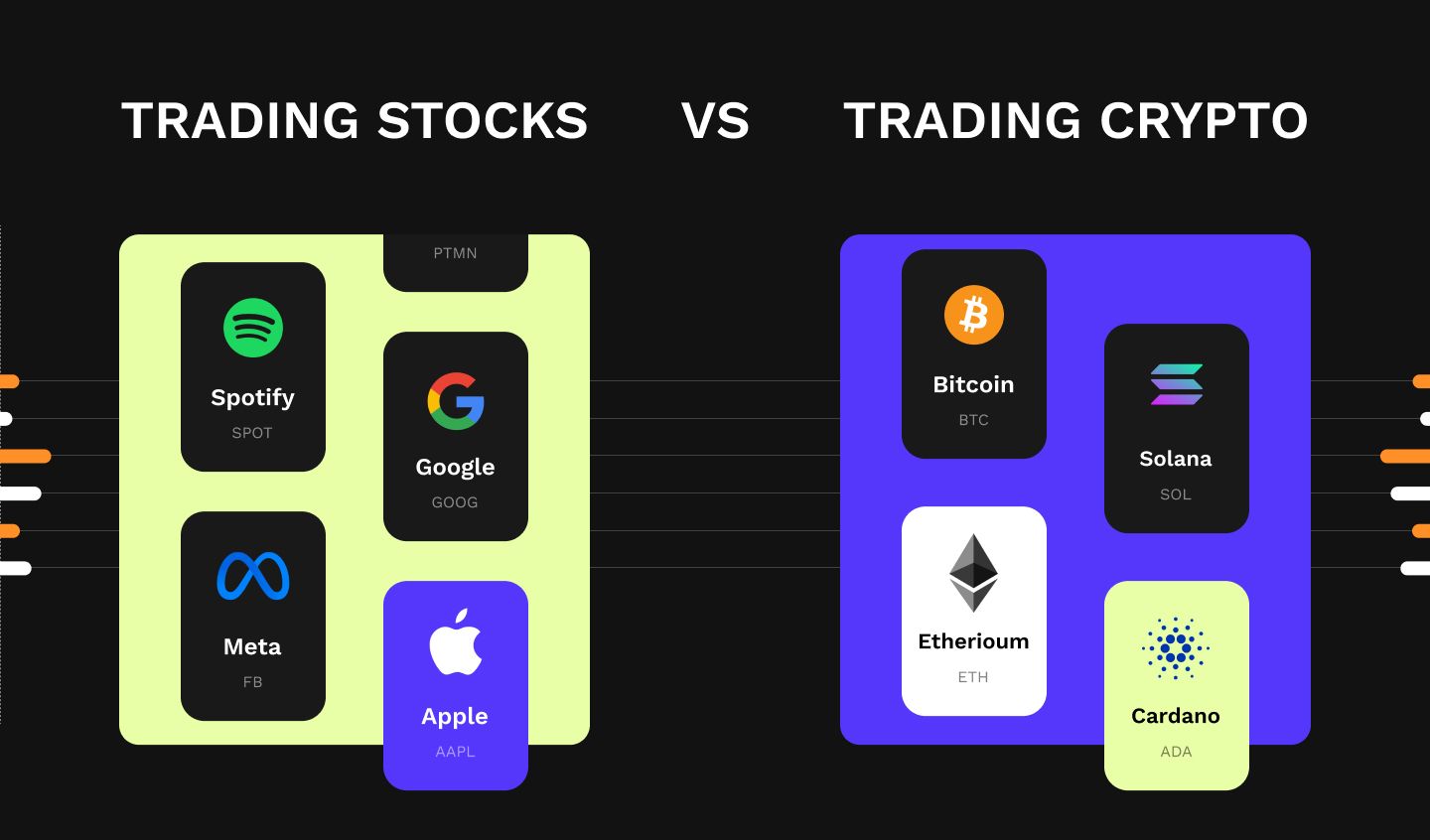
We’ll assume you already have an authorized brokerage business and are just seeking info on how to make a trading platform to expand into mobile markets. This custom trading platform development guide can help you with this. But just in case you’re planning an app or mobile site to be your starting point, you’ll need to decide on the type of your platform beforehand.
Let’s take an asset being traded as the core differentiator and divide trading systems into two main categories: traditional stock- and cryptocurrency-oriented. Which one to choose? Let’s find out more about each type.
Traditional stock trading platform
The stock trading market has been around for much longer than cryptocurrency exchanges, and is heavily regulated, so it’s considered more mature. Stocks are backed by companies that have to go through multiple government check procedures and comply with certain regulations to list those stocks.
An online stock trading system can be a gold mine both for its owner and for users:
- For users, a mobile stock trading site or app allows them to check the stock market whenever they want, via smartphone or tablet. It also offers control over investments and unrivaled transparency.
- For brokers, it’s a chance to expand and gain customers among the younger, mobile-fixated population: while long-term investing is all shades of a nightmare for US Millennials for various reasons (student loans being a major one), they do engage in stock trading, and increasingly so, according to research.
With stock trading transactions made via a broker, there is always insurance in place. For example, the Security Investor Protection Corporation (SIPC) and Federal Deposit Insurance Corporation (FDIC) provide insurance coverage up to $500,000 if due to the brokerage actions a trader loses their deposits.
Cryptocurrency-oriented trading platform
If you want to build a crypto trading app, it means you’ll be an intermediary between “makers” and “takers”, allowing fiat-to-crypto and/or crypto-to-crypto transactions to happen. Unlike stocks that represent shares in real companies, cryptocurrencies are digital coins with subjective value since everyone can create that.
However, entering the crypto trading market could be quicker than stock trading, for both a broker and individual crypto traders. It might require less paperwork to register and get your crypto exchange business licensed. As for your users, all they need to do is sign up, verify their account, and connect with their crypto wallets.
How to start your own stock exchange platform: legalities
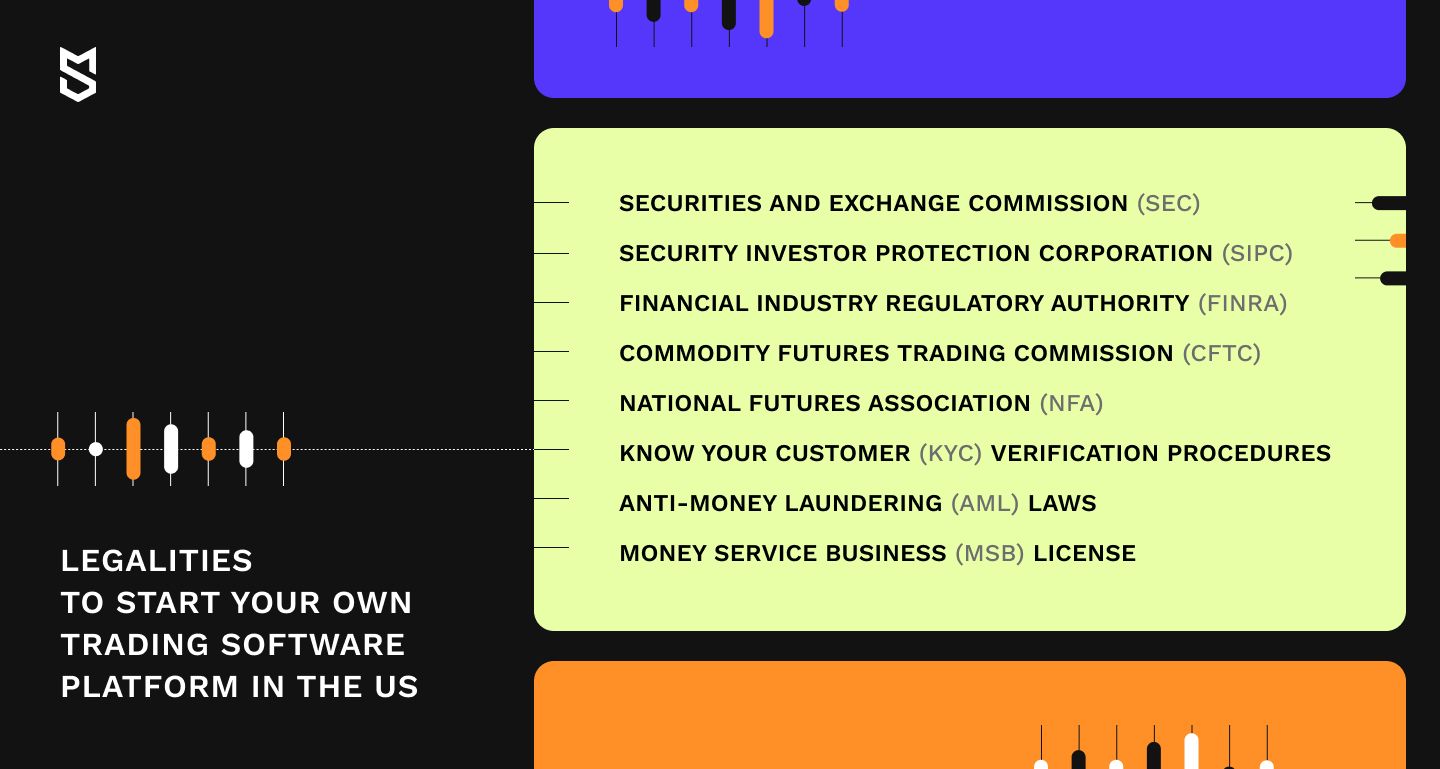
Once you reach a common denominator regarding the assets you’ll offer for trading, you’ll need to take care of the legal part of your stock and/or crypto trading app development.
As a stockbroker, you’ll be dealing with securities and money. Therefore, if you’re operating in the US, you’ll be under the watchful eye of the Securities and Exchange Commission, or the SEC for short. In Europe, you have to meet the General Data Protection Regulation (GDPR) standards. If you’re in a different country, there’s most likely a regulatory body there as well.
It would also be good for your credibility to participate in investor protection programs and join regulatory organizations. For example, both E-Trade and Robinhood are members of SIPC and FINRA. If you’re going to trade futures and derivatives as well, it’s worthwhile to become a member of the National Futures Association and the Commodity Futures Trading Commission (CFTC).
You’ll need to obtain a license in every country your trading software platform will be operating in. Getting licenses and joining regulatory organizations cost different amounts in different states, let alone countries. But one common part of the process, no matter where you are, is a background check.
In some states (like California, for example), you’ll need to even submit your fingerprints. You’ll need to go over the particular requirements in the states and countries your custom trading platform will operate in.
Stock market apps: competitors
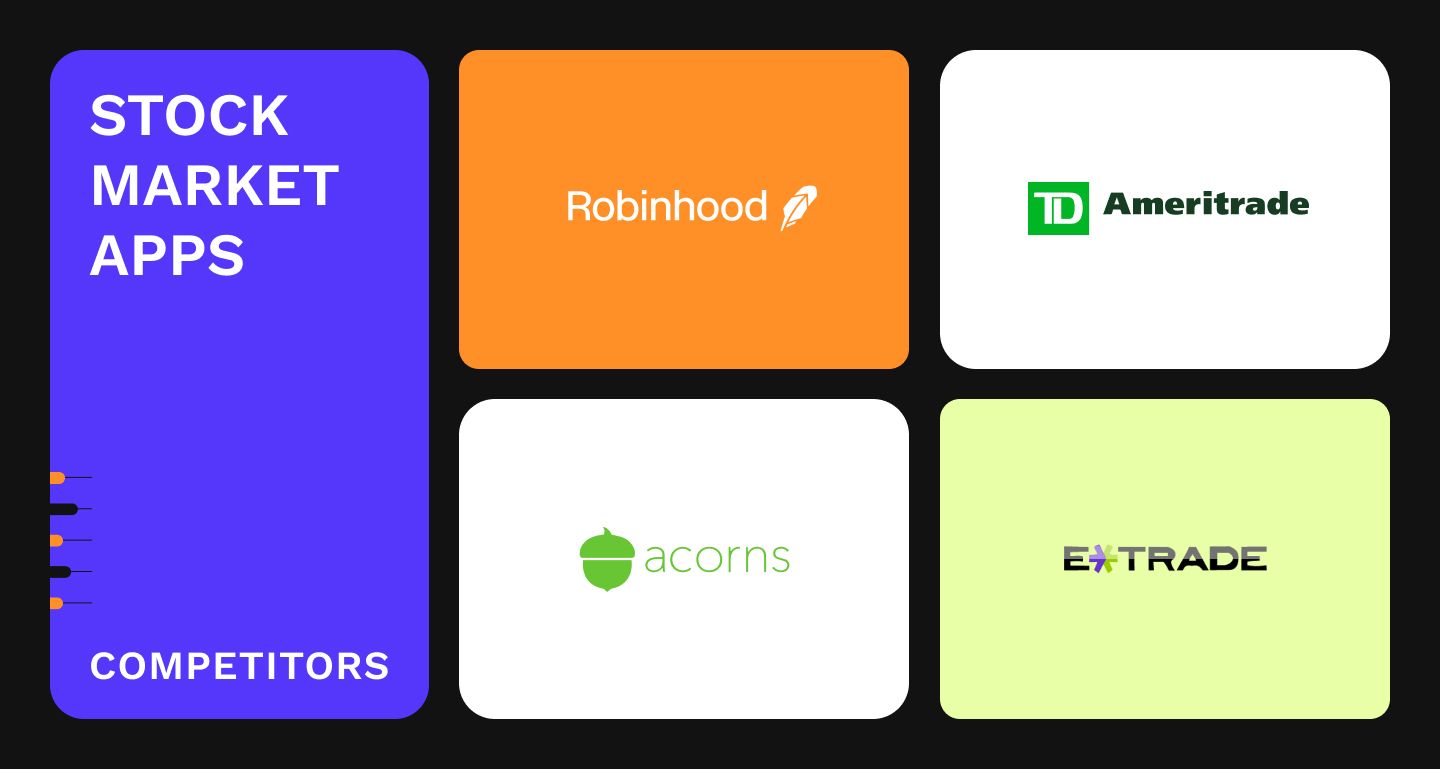
The US market for individual investors and traders is highly competitive, and many of the players have caught up to the mobile platform trend; you’ll have a range of apps to win customers from.
Here’s a short analysis of what existing apps offer, starting with the two apps mentioned above.
E-Trade
E-Trade was the first stock trader to go online, years ago. The firm has two separate platforms for trading: the original E-Trade and the new Power E-Trade app. Both are available for desktop as well as for Android and iOS mobile devices.
The fees for E-Trade are higher than for most other companies, but the variety of trades they make available on mobile devices is hard to rival.
E-trade offers trading in stocks, mutual funds, bonds, options, ETFs, and futures. The web platform provides live quotes, charts, and market commentary. E-Trade stands out for its advanced customer support, offering 24/7 assistance through in-app chat, email, and phone. More so, the platform has high marks for its research and learning tools.
Robinhood
The selling point of Robinhood is that trades are fee-free, meaning you don’t pay any commission for your deals. Robinhood was initially geared toward mobile use, and the app was created even before the website. As a result, the app is really polished and easy to use.
With the Robinhood app, users can trade in stocks, options, ETFs, and cryptocurrency (Bitcoin and Ethereum). It provides a ton of valuable information, including real-time market data and charts, quarterly earnings reports, market news, and stock details. What’s more, the Robinhood app allows its Android users to sync to their smartwatches to read alerts in the fastest way possible.
TD Ameritrade
This is another giant. With TD Ameritrade, you can choose an app according to your experience. The regular TD Ameritrade Mobile app is beginner-friendly and provides a wealth of research data and advice; it’s got everything a once-in-a-while trader might need.
For more savvy and active investors, the TD Ameritrade Mobile Trader app gives a variety of charts and indicators, real-time streaming quotes, analyst reports, and market news. Its variety of assets for trading is impressive: stocks, mutual funds, bonds, ETFs, options contracts, forex futures, and Bitcoin futures. It’s also possible to customize your dashboard and screens within the TD Ameritrade platform.
Acorns
Acorns is a robo-advisor, an automated trading system that does everything for its users in terms of trading in ETFs. Acorns uses the information you provide about yourself to select five collections of ETFs (portfolios). Choose one and set your investment schedule, which can be daily, weekly, or monthly.
When you pay with the card connected to your Acorns account, the system automatically rounds the payment up to the next dollar and the difference goes to your Acorns account and gets invested. It’s a system perfectly suited for students and people who don’t really care much about trading but would like to have some extra cash and savings.
Each of these trading platforms has something that sets it apart from others on the market, like TD Ameritrade’s customizable dashboard and Robinhood’s smartwatch sync. To stay afloat in a highly competitive market, it’s vital to have a unique feature.
Form business tasks to create a trading platform
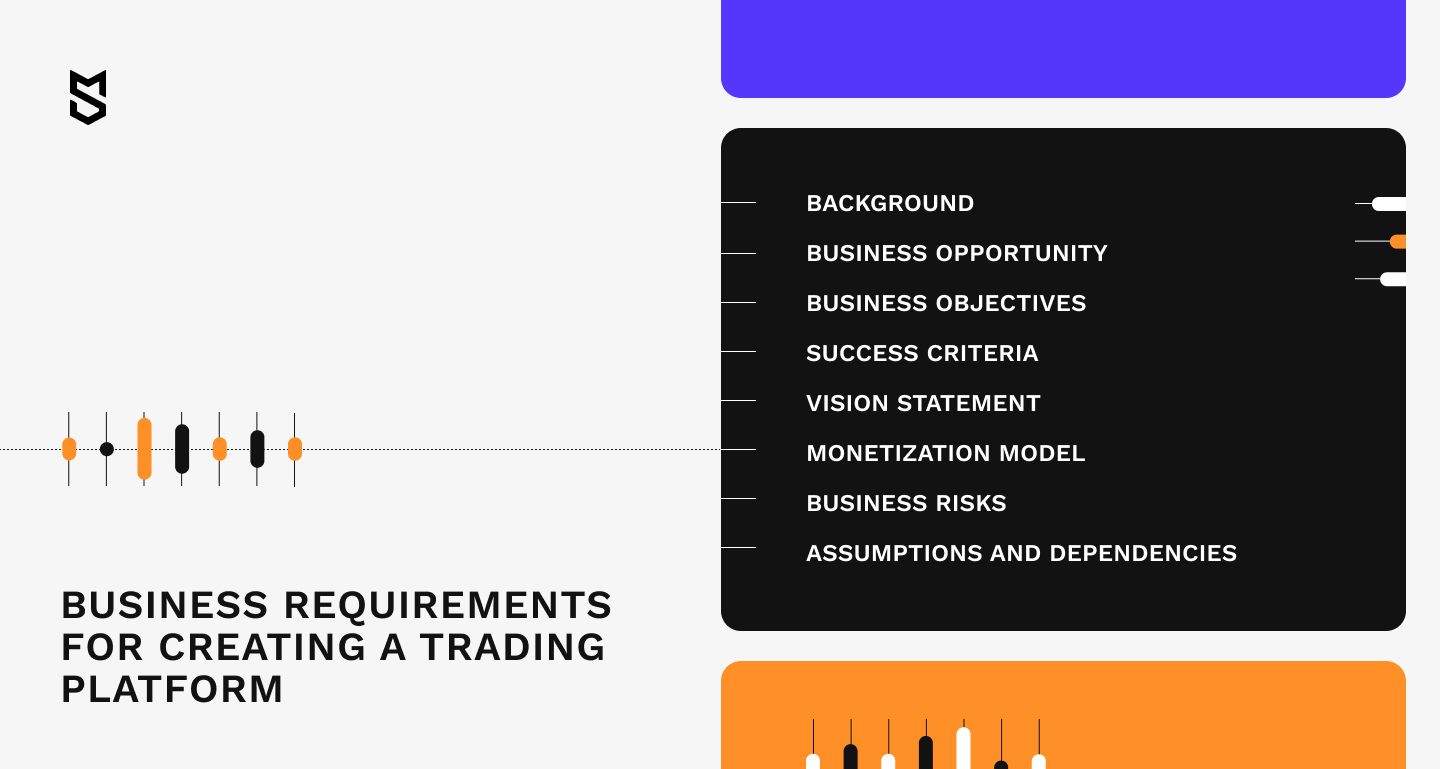
After choosing your trading software platform type and taking a closer look at your main competitors, it’s time to conduct a thorough target user analysis. Based on received insights, you’ll be able to validate your project idea, adjust it according to users’ expectations, and draft your business requirements. This will streamline the process of stock market app development for developers.
We’ve described how to compile a product requirements documentation (PRD) including business, user, and system requirements in one of our previous articles. So here we’ll highlight the core ingredients for the business part of your PDR:
- Background. Describe your main driver to create a stock trading platform, what goals you plan to achieve with this project, and how it will improve your current business situation.
- Project vision. Outline your custom trading platform type, core features, how it will serve your target users, and how it will beat your main competitors.
- Business opportunity. Describe your custom trading platform’s main advantages, its unique value proposition, and the ways you plan your platform to evolve.
- Business objectives. Write down your expectations regarding the revenue and time to get a return on investment in the form of SMART (specific, measurable, achievable, relevant, and time-bound) objectives.
- Success metrics. Highlight the indicators reaching which will signal all stakeholders of the development process that your trading site has achieved success.
- Monetization model. Decide on how your stock trading system will earn money. Remember, you need to keep the balance between your platform's competitiveness, attractiveness to users, and at the same time profitability for you as an owner.
- Limitations and dependencies. Highlight all roadblocks you’re aware of up to this moment that can influence your custom crypto trading app development: government policies, legalities, bans for particular coins, difficulties in getting licensed, lack of financing, etc.
Successful stock market app: a word of advice for development
Before we jump to the list of necessary features for a stock trading app, here’s a word of advice from the leaders: don’t be a Scrooge about the UI design. Stock trading is a complicated process, and it’s easy to get lost when you’re a novice. Don’t add to the confusion; eliminate it instead.
It is estimated that almost one in five traders globally find crypto exchange platforms’ interfaces inconvenient. So making your stock trading system design as straightforward as possible could serve as a powerful magnet for attracting users.
The more user-friendly your design is, the more time users will spend trading. Regardless of your monetization plan, stock trading businesses all benefit from customers investing more.
Now let’s run over the features you’ll need to include.
Stock trading application features to consider
During the stock trading app development, take your cue from industry leaders. Here’s the must-have functionality:
Authorization
The sign-up/login screen needs to combine simplicity with data security. Stock trading apps deal with finances; users will fill in their names, addresses, social security numbers, and credit card credentials. All this sensitive data must be protected and encrypted. At the same time, if the authorization process is too long or hard to navigate, you risk losing potential customers. Make it safe and simple.
Note: Some platforms log users via Touch ID or Face ID.
Profile page
User profiles contain a wealth of information and need to be easily editable.
Dashboard
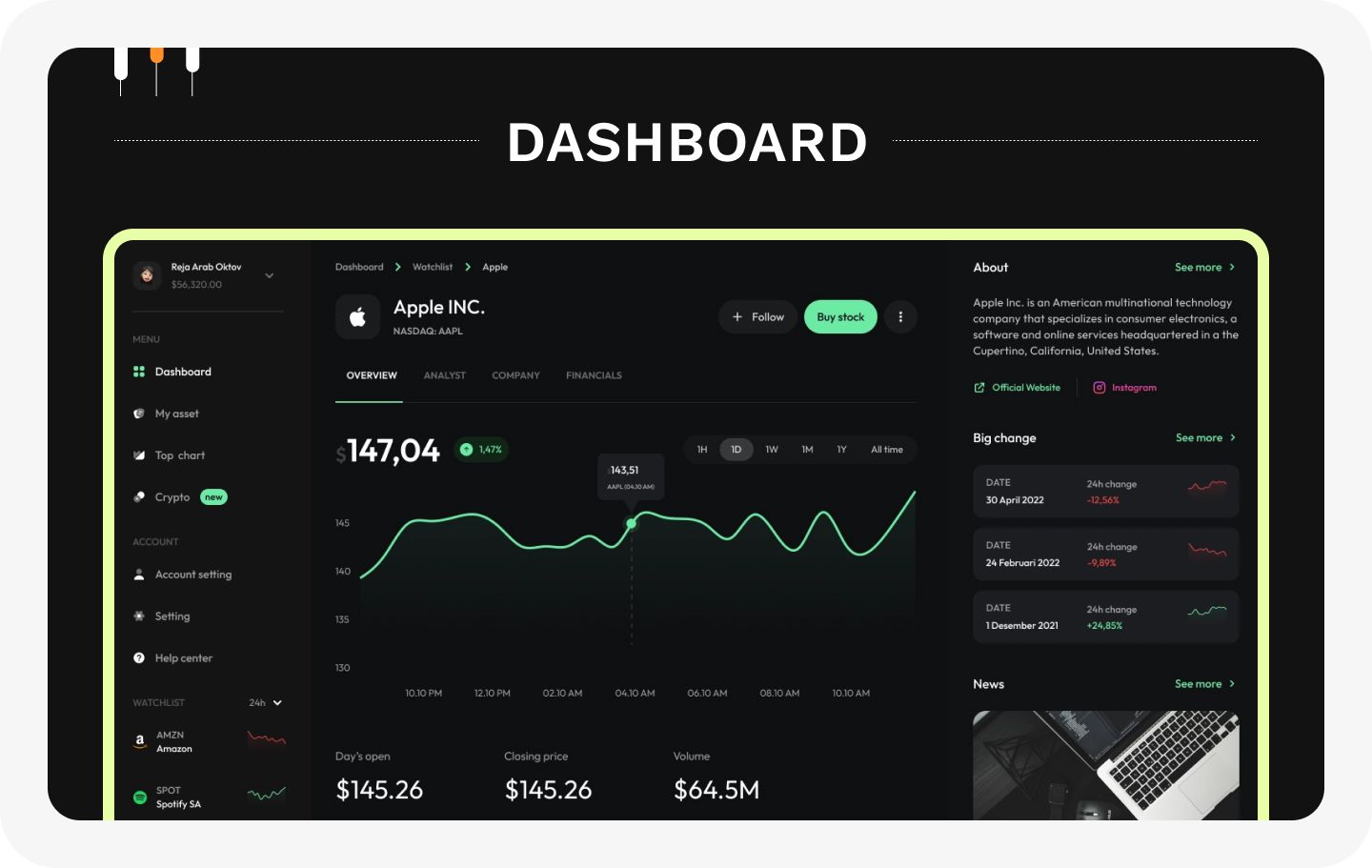
This is where all the data a user might need about their stocks is displayed. Before you decide how to build your trading platform, think of the dashboard from a novice trader’s point of view. There’s a ton of data usually displayed on a dashboard: watchlist, order status, balance, holdings, charts, and so on. It’s important to present all this information in an easy-to-understand way.
Portfolios
It would be sensible to implement filtering and sorting for portfolios to make it easier for users to find what they need.
Trading functionality
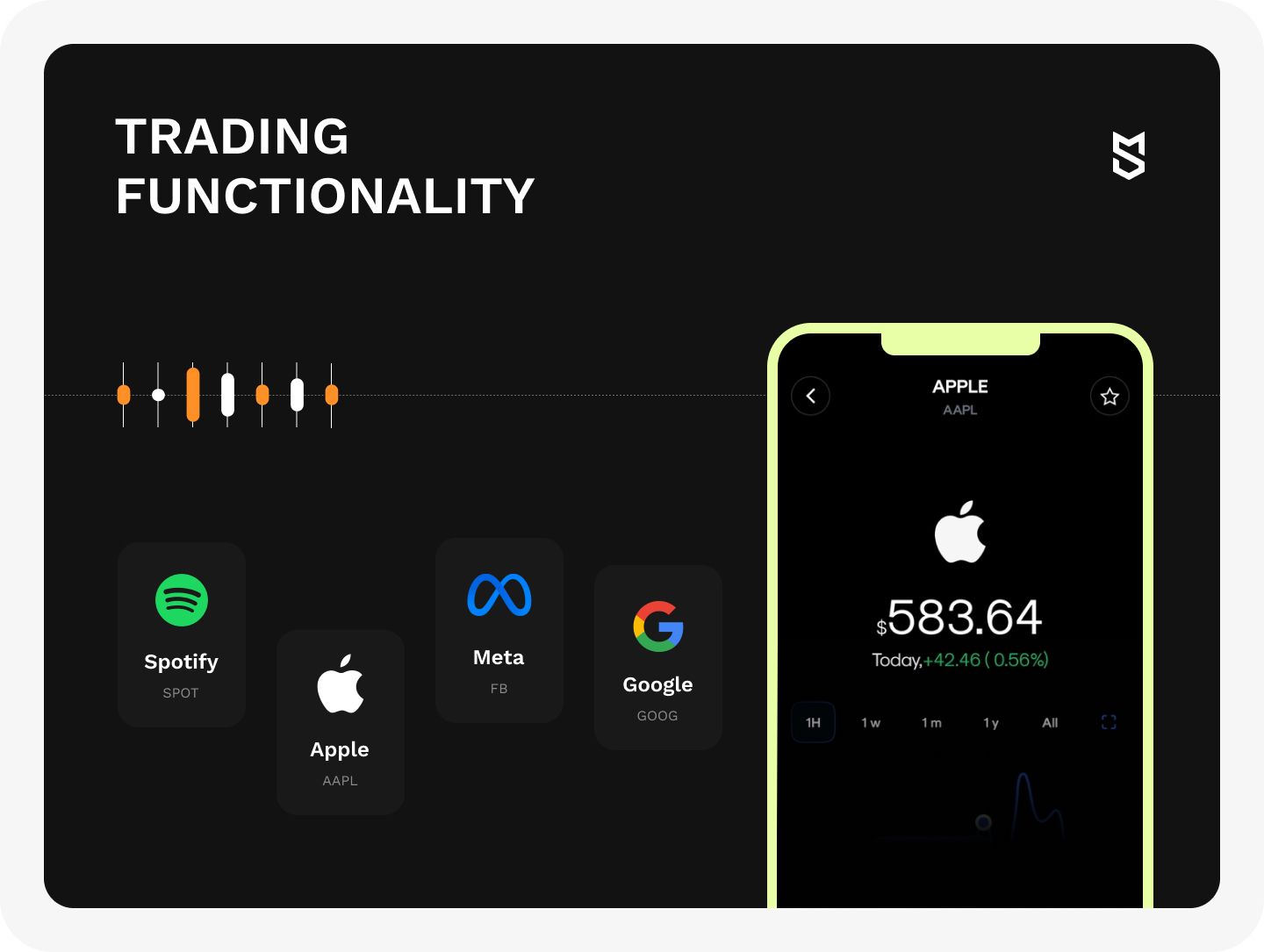
This is the core of your app; the reason you're developing it. Trading needs to be smooth, so you need to think about how to display real-time data, company profiles, and other information that’s relevant when making an investment decision.
Fund transfers and payment gateway

To buy and sell stocks, you need money transfer functionality. The gateway you use must be highly secure.
Streaming quotes and charts
Stock trading is a rapid business at times, and decisions are often split-second. For this reason, any stock information in your app needs to be precise and up-to-date. Live streaming charts and quotes will enable users to make informed decisions. The sources must be reputable, too: for example, CNBC or Bloomberg.
Newsfeed, analysis, and forecasts
News from financial outlets is especially important to experienced traders, as any disturbance can be a reason for a stock to rise or fall in price. Being informed about happenings with companies may help people to predict price fluctuations.
Notifications
For the same reason you need streaming charts you also need push notifications. Let users set conditions for notifications so they don’t miss important changes in the stock market.
Watchlist
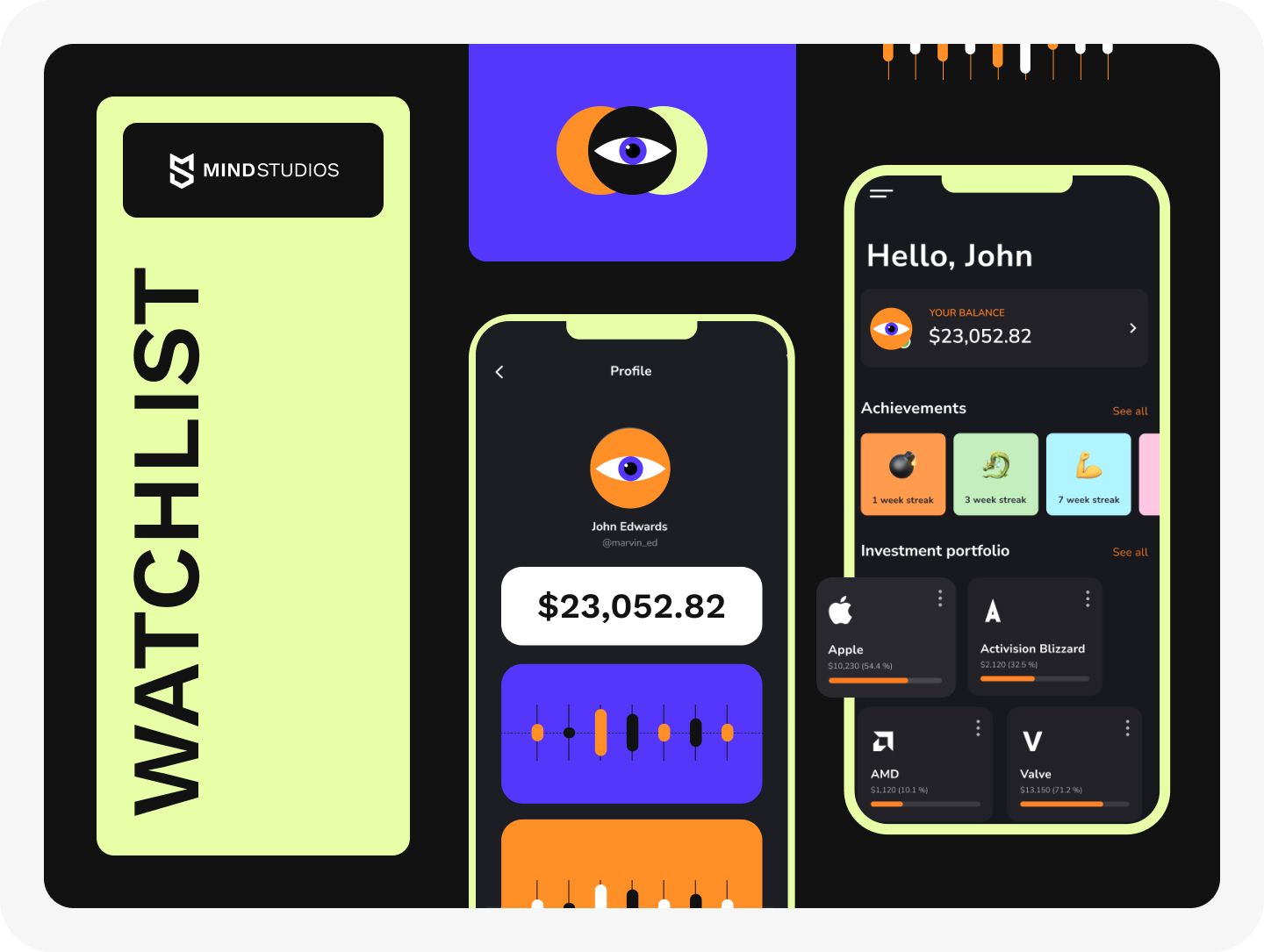
To easily track stocks they’re interested in, users can add them to a watchlist instead of using search and filters every time.
Synchronization
If you’re considering creating a trading platform for more than one type of device (which is what we recommend doing), you definitely need to take into account syncing. Most active traders use more than just their smartphone or tablet. Websites and desktop applications are usually more convenient for analyzing stock data on bigger screens. Consequently, you need account data to sync smoothly between devices.
Ensure the security of your stock market app
Your stock trading application will be tightly knitted with processing sensitive information of your target users. So it is of utmost importance that you make your own stock market app as safe and secure as Vatican Archives.
To make your data protection feature a trump card, rely on the following security tools:
- Multi-factor authentication (MFA)
- Know-Your-Customer (KYC) verification procedure
- End-to-end encryption (E2E) for transactions
- Real-time alerts about cyberattacks threats
- Non-Disclosure-Agreement (NDA) signed between you and your development provider
- The Open Web Application Security Project (OWASP) tests
- Next-gen firewalls, antivirus software, cloud computing deployment models
- AI-based systems for fraud detection
Stock market app development tech stack
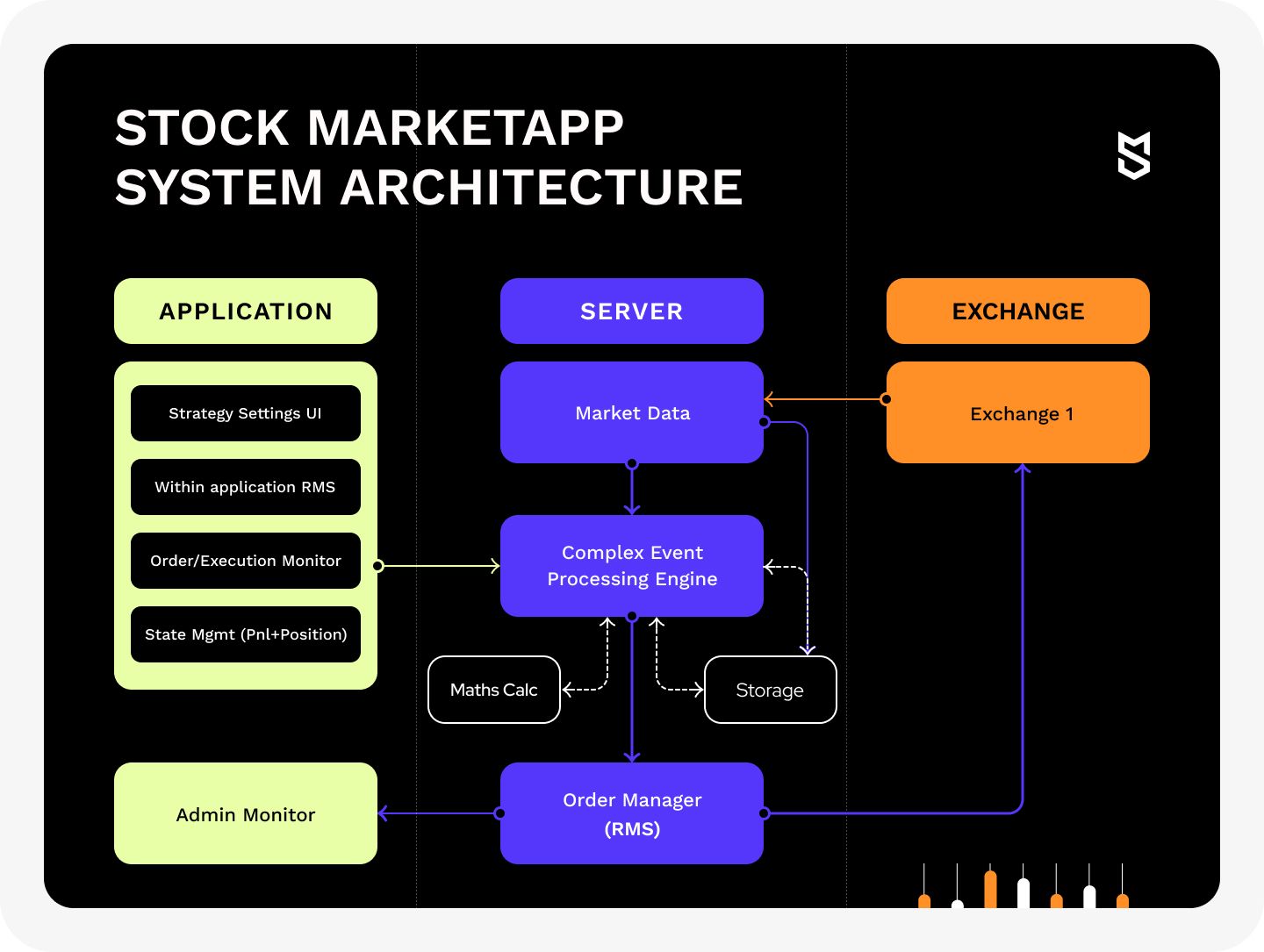
When deciding how to build a trading system, you first need to decide whether you need a mobile version of your existing stock market website or a full-fledged app. Generally, an app offers more flexibility and functionality than a mobile-adapted website.
If you do settle on an app, the next step is to choose the platform: Android, iOS, or both. Research what platform the majority of your customers (or potential customers, if you’re developing a mobile-first stock trading platform like Robinhood did) use. Creating an app for both platforms at the same time is usually a good idea.
Stock market platform development poses quite a number of technical challenges regardless of platform. For example, it’s difficult to run tests since the stock market doesn’t work 24/7.
Luckily for developers, a number of companies today offer use of their APIs. One of those companies is E-Trade. They provide APIs as well as SDKs to third-party developers.
Of course, E-Trade APIs are not the only ones on the list. If you want to know how to build a stock trading app that will provide traders with the latest market trends of various stocks in an accurate, precise, and speedy way, consider the following stock market APIs to choose from:
- Stock News API
- IEX Cloud API
- Bloomberg API
- Alpaca API
- Intrinio API
Apart from stock market APIs, we’ve prepared a rundown of other technologies our developers tend to use for developing fintech software projects:
| Type of work | Technology |
|---|---|
| Frontend development | JavaScript |
| Frontend framework | Vue.js, React.js, web3.js |
| iOS development | SwiftUI |
| Android development | Kotlin |
| Backend development | Ruby, Node.js |
| Backend frameworks and libraries | Ruby on Rails, Bootstrap, Express/Nest.js |
| Databases | MySQL, PostgreSQL, MongoDB |
| Analytics and monitoring | Amazon CloudWatch, Datadog, Prometheus |
| Source code storage | AWS CodeCommit, GitHub, GitLab |
| Crypto wallet providers | MetaMask APIs, Trust Wallet APIs |
| Multifactor authentication | Twilio Authy |
Assemble a development team for your stock market app
To make your stock market app development run without a hitch, you need to enlist the help of a qualified software development team, preferably experienced in building similar trading platforms and for a reasonable price.
When it comes to developing custom trading software working on the web, iOS, and Android platforms, you may require the following number of specialists:
- UI/UX designer — 1
- Front-end developer — 1
- iOS developer — 1
- Android developer —1
- Backend developer — 2
- Blockchain developer (in case you plan to develop a decentralized crypto exchange platform) — 1
- Development Operations engineer —1
- Quality assurance specialist — 2
- Project manager — 1
If you decide to make a stock market app with Mind Studios, the process of our collaboration will look like this:
- Our project manager (PM) will examine your initial product requirements, complement them with specifications, and put them into the product backlog.
- Keeping you informed, the PM will split the requirements from the product backlog into iterations (they usually last around two weeks and are called sprints).
- After sprints are set, the team embarks on your project development with daily stand-up meetings to monitor the project progress.
- At the end of each sprint, our team invites you to the sprint review meetings where they demonstrate the intermediate versions of your product and check whether it matches set requirements and KPIs.
Stock market app development cost and time
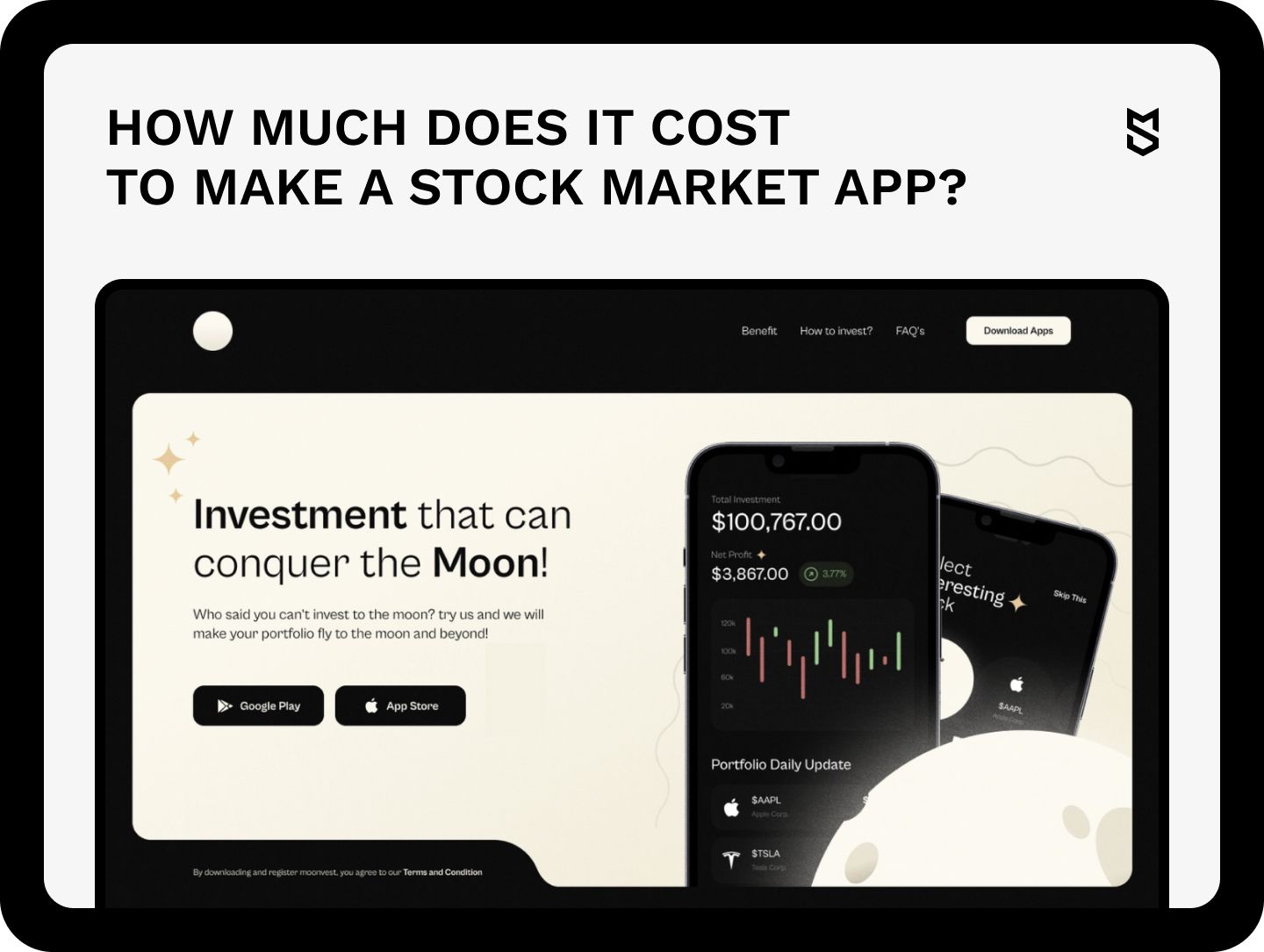
Each outsourcing app development company has its own specific process when it comes to building apps. The cost and quality of the app will depend on that process, as will the time necessary for development.
At Mind Studios, we start app development with the discovery stage. This stage is meant to find that unique value your app will offer that no other app does. Here are the development stages we go through:
- Discovery. At this stage, we dive deep into your idea and build a Business Model Canvas to follow as we create your online stock trading system. This stage is filled with analysis and brainstorming.
- Idea validation. Validating your app idea will help you determine how to go about development so that your product ends up a success.
- UX strategy. This is where the detailed plan for the interface is created and high-fidelity prototypes are built.
- Design and development. At this stage, you can be certain your product has a market and your money won’t be wasted. Finally, the actual development starts.
- Testing and deploying. Here, we will polish your product by getting feedback from testers, identifying bugs, and fixing them. All this is done to successfully launch your platform and lower the possibility of negative user experience and high bounce rate.
There’s no way to estimate the precise cost of developing an app, whatever that app might be. What we can do is make a ballpark estimate based on the general scope of features.
Stock market apps require a number of complicated features like news feeds, forecasts, and real-time quote updates as well as functionality for money-related operations. Depending on how many features you need, the time needed to develop a trading platform will increase and the price will rise.
If we’re thinking of minimum necessary functionality and rates of about $45 per hour, then building a stock trading mobile app for both platforms can cost anywhere from $104,000 and up. See details below:
| Stage | Time, h | Cost, USD |
|---|---|---|
| Business analysis and market research | 80+ | 3,600 |
| Prototyping and UI/UX design | 160 | 7,200 |
| iOS development | 420 | 18,900 |
| Android development | 420 | 18,900 |
| Backend development | 640 | 28,800 |
| Project management | 280 | 12,600 |
| Testing | 320 | 14,400 |
| Total | 2,320 | 104,400 |
Mind Studios’ experience
Our developers are no strangers to the tech stack used to build a custom trading platform. We’re currently working on a blockchain-based gaming ecosystem XManna, so we’ll overcome any challenges that a decentralized cryptocurrency exchange platform can carry.
After our team mastered the Monte Carlo mathematical method to develop a mobile-only calculator for short-deck poker players Six+ Odds, we can say for sure we’re ready to build a well-thought-out stock trading system architecture.
If you’re aiming to diversify your custom trading platform with additional functionality like NFT trading, we have experience in implementing NFTs in a 2D arcade game as well.
Summing up
In this article, we’ve pursued the goal to provide you with exhaustive information on the question of how to make a trading platform. However, with a variety of market trends, types of trading platforms, technologies that can be used, and initial product requirements, it’s hard to fit all the information into a readable-sized article.
If you need a more precise estimate or if you have questions about creating a trading website or application, you can get in touch with us and ask for a quote or a consultation.

